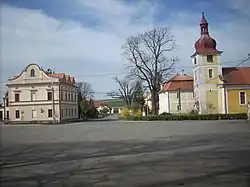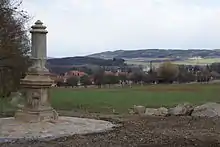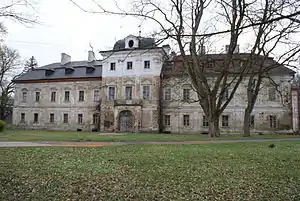Dolní Lukavice
Dolní Lukavice (German: Unter-Lukawitz, Unterlukawitz) is a municipality and village in Plzeň-South District in the Plzeň Region of the Czech Republic. It has about 1,100 inhabitants.
Dolní Lukavice | |
|---|---|
 Centre of the village | |
 Flag  Coat of arms | |
 Dolní Lukavice Location in the Czech Republic | |
| Coordinates: 49°36′10″N 13°20′2″E | |
| Country | |
| Region | Plzeň |
| District | Plzeň-South |
| First mentioned | 1216 |
| Area | |
| • Total | 18.73 km2 (7.23 sq mi) |
| Elevation | 355 m (1,165 ft) |
| Population (2023-01-01)[1] | |
| • Total | 1,103 |
| • Density | 59/km2 (150/sq mi) |
| Time zone | UTC+1 (CET) |
| • Summer (DST) | UTC+2 (CEST) |
| Postal codes | 334 01, 334 44 |
| Website | www |
Administrative parts
Villages of Krasavce, Lišice and Snopoušovy are administrative parts of Dolní Lukavice.
Geography

Dolní Lukavice is located about 14 km (9 mi) south of Plzeň. It lies on the border between the Plasy Uplands and Švihov Highlands. The highest point is the hill Hájsko with an altitude of 524 m (1,719 ft). The Úhlava River flows through the municipality.
History

The first written mention of Dolní Lukavice is from 1216. From the mid-15th century until 1596, the village was in possession of the Lukavský of Řenče family. The most notable owners of Dolní Lukavice was the Morzin Family, who bought it in 1666. They had the old local fortress demolished and had a new Baroque castle built. They held the estate until 1780, when Karl Joseph, Count Morzin sold it to Count Karel Bedřich of Hatzfeld.[2]
During the mid-18th century, the Morzin family was very musical, and in the late 1750s they hired the young composer Joseph Haydn to serve as their Kapellmeister (music director), leading the family's small orchestra. Haydn followed the Morzins back and forth in their annual migrations: summers in Dolní Lukavice (referred to as "Lukavec" in most Haydn biographies), and winters in the imperial capital of Vienna.[3]
Demographics
|
|
| ||||||||||||||||||||||||||||||||||||||||||||||||||||||
| Source: Censuses[4][5] | ||||||||||||||||||||||||||||||||||||||||||||||||||||||||
Sights
Dolní Lukavice is known for the Dolní Lukavice Castle (also called Morzin Palace). It was built according to design of Jakub Auguston in 1707–1728. It is surrounded by a large English park. Today the palace is in poor condition and empty.[6][7]
The Church of Saints Peter and Paul was built in the early Gothic style around 1340 and first documented in 1352. In the second half of the 15th century, late Gothic modifications were made, and in 1722, the church was baroque rebuilt probably by Jakub Auguston.[8]
References
- "Population of Municipalities – 1 January 2023". Czech Statistical Office. 2023-05-23.
- "Historie: Dolní Lukavice" (in Czech). Obec Dolní Lukavice. Retrieved 2021-06-07.
- Geiringer, Karl (1982). Haydn: A Creative Life in Music. Berkeley: University of California Press. p. 36.
- "Historický lexikon obcí České republiky 1869–2011 – Okres Plzeň-jih" (in Czech). Czech Statistical Office. 2015-12-21. pp. 3–4.
- "Population Census 2021: Population by sex". Public Database. Czech Statistical Office. 2021-03-27.
- "J'habite dans le château où composait Haydn" (in French). Czech Radio. 2007-10-02. Retrieved 2020-07-28.
- "Zámek" (in Czech). Obec Dolní Lukavice. Retrieved 2022-11-13.
- "Kostel sv. Petra a Pavla" (in Czech). Obec Dolní Lukavice. Retrieved 2022-11-13.